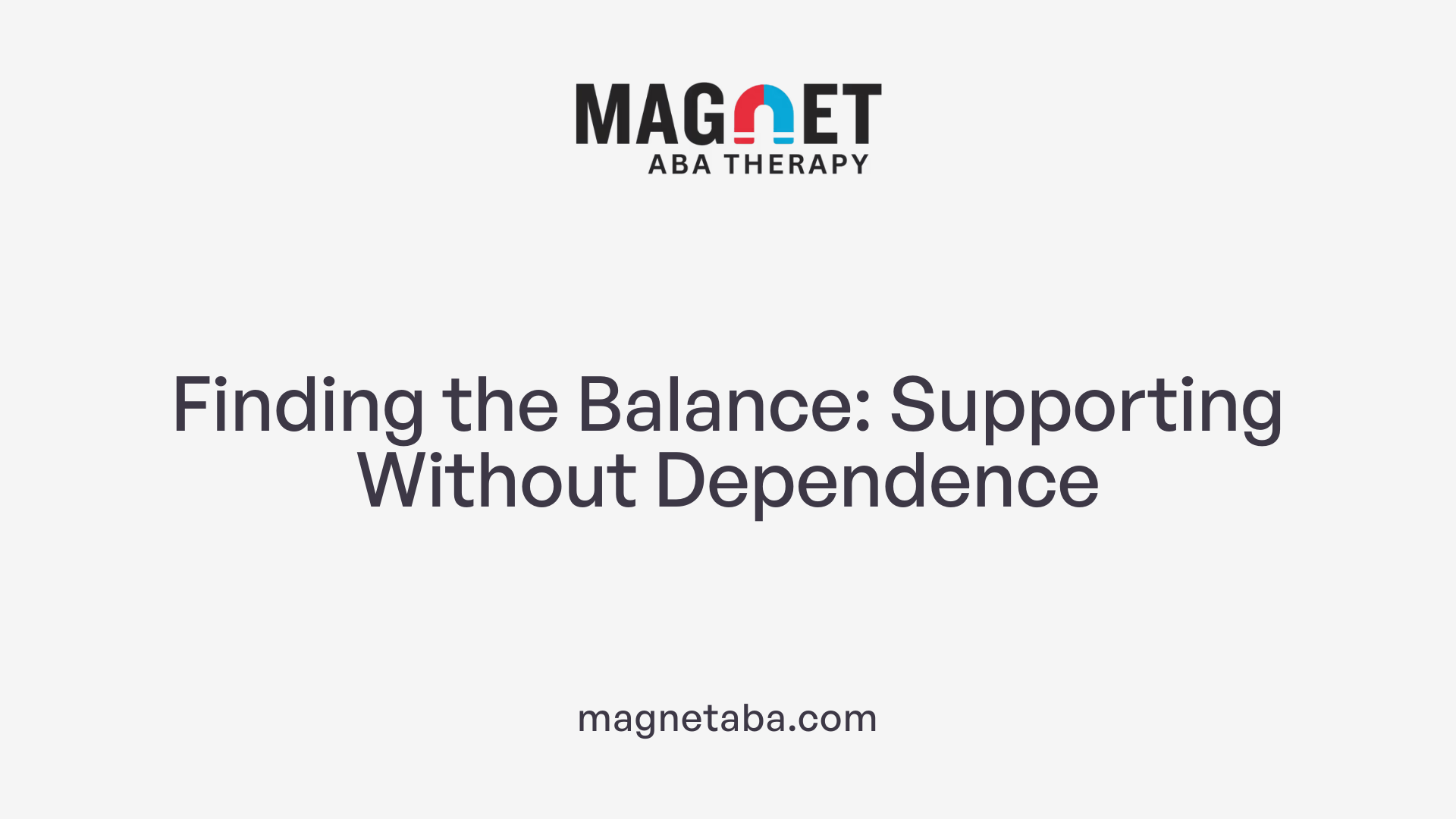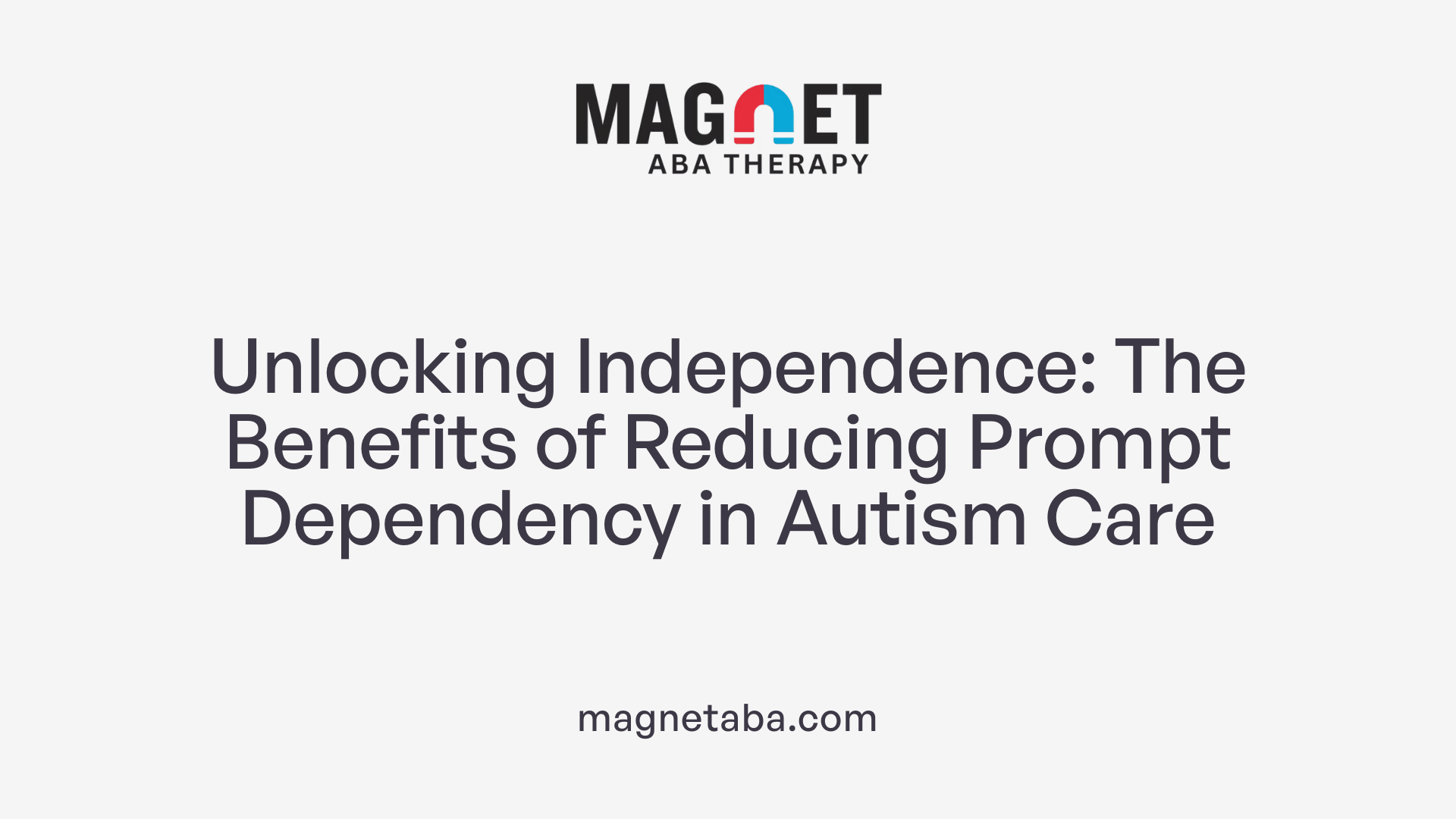Understanding Prompt Dependency in ABA
Applied Behavior Analysis (ABA) therapy is a cornerstone intervention for individuals with autism, emphasizing behavior development and skill acquisition through structured teaching methods. Among these methods, prompt hierarchies play a pivotal role, guiding learners with cues that assist skill mastery. However, excessive reliance on prompts can hinder the ultimate goal of fostering independent behavior. This article explores how prompt dependency arises in ABA therapy and presents practical strategies to reduce it, ensuring meaningful, autonomous skill use by individuals with autism.
The Foundations of ABA Therapy: An Overview
What is Applied Behavior Analysis (ABA) therapy and how is it used for autism?
Applied Behavior Analysis (ABA) therapy is a scientific approach that focuses on understanding and modifying behavior through learning principles. It is particularly effective for supporting individuals with autism spectrum disorder (ASD) by promoting skill acquisition, reducing challenging behaviors, and enhancing social and communication abilities.
ABA therapy is highly individualized; it tailors interventions based on each person's unique strengths and needs. Qualified professionals, such as Board Certified Behavior Analysts (BCBAs), design and oversee treatment plans. These plans often include strategies like positive reinforcement to encourage desired behaviors, prompting methods to assist skill learning, and naturalistic teaching techniques that embed learning in everyday situations.
A hallmark of ABA therapy is ongoing data collection and assessment. Practitioners continuously monitor progress, adjusting goals and interventions to maximize effectiveness. Early, intensive ABA interventions have been shown to lead to notable developmental gains and increased independence for children with autism.
How is ABA therapy applied for individuals with autism?
ABA uses structured and systematic teaching methods to build meaningful skills. This includes teaching daily living, communication, social interaction, and academic skills. The therapy also addresses challenging behaviors by identifying their causes and replacing them with more appropriate alternatives.
What is the role of professionals in delivering ABA services?
Certified specialists such as BCBAs develop assessment-driven treatment plans and train ABA therapists to implement these plans consistently. Their expertise ensures that therapy is evidence-based, ethical, and adjusted to meet each learner’s evolving needs.
Who Delivers ABA Therapy? The Professionals Behind the Process

Types of ABA Providers
ABA therapy services are primarily delivered by highly trained professionals including Board-Certified Behavior Analysts (BCBAs) who design treatment programs, licensed therapists who implement interventions, and Registered Behavior Technicians (RBTs) who provide direct one-on-one therapy. These clinicians have specialized education and practical experience in behavioral analysis.
Settings Where ABA Is Delivered
ABA therapy takes place in various familiar environments such as the child's home, preschools, clinics, and community settings. This flexibility helps promote skill generalization by allowing children to practice newly acquired behaviors in multiple contexts.
Role of Caregivers in Therapy
Parents and caregivers play a vital role in ABA therapy by supporting the child's progress between sessions, reinforcing skills, and learning strategies to promote independence. They often collaborate closely with therapists to carry over interventions and help maintain consistency across settings.
Who provides ABA therapy services?
ABA therapy services are primarily provided by highly trained professionals such as BCBAs and licensed therapists with behavioral analysis expertise. These professionals create individualized programs tailored to the child's needs and often provide direct therapy in environments familiar to the child like home or community settings. Caregivers also actively participate, ensuring skill generalization and reinforcement. Delivery may come through specialized clinics or companies and may be covered by insurance or Medicaid, guaranteeing access to evidence-based ABA treatment.
Prompt Hierarchies in ABA: A Systematic Approach to Teaching
What Are Prompt Hierarchies?
Prompt hierarchies are a structured system of cues used in Applied Behavior Analysis (ABA) to support learning. They involve a carefully planned sequence of prompts that move from the most direct to the least intrusive, helping individuals acquire new skills while gradually promoting independence.
What Types of Prompts Are Used?
Various prompt types are organized within these hierarchies, including:
- Physical prompts: Guiding a person's movements directly, such as hand-over-hand assistance.
- Modeling prompts: Demonstrating the desired behavior for imitation.
- Verbal prompts: Using spoken instructions or reminders.
- Gestural prompts: Employing gestures like pointing to guide attention.
- Visual prompts: Providing visual cues such as pictures or symbols. These prompts are applied systematically from more intrusive to less intrusive levels to tailor support according to individual needs.
What Is the Purpose of the Prompt Sequence?
The sequence of prompts is designed to help learners master targeted behaviors while reducing prompt dependence. Starting with more supportive prompts ensures initial success and confidence. Gradually fading prompts encourages autonomous skill performance, increases motivation, and facilitates generalization to different settings. This approach makes skill acquisition systematic and individualized, leading to improved independence over time.
Balancing Support and Independence: The Challenge of Prompt Dependency

Causes of Prompt Dependency
Prompt dependency arises when learners rely excessively on prompts to perform tasks, hindering their ability to respond independently. This often occurs when prompts are not faded systematically or when prompts are too intrusive, such as full physical guidance used for longer than necessary. Individual differences also play a role; some learners require more time and tailored strategies to transition away from prompts.
Impact on Skill Acquisition and Independence
While prompts are essential to initial skill learning, over-reliance can inhibit a learner's ability to apply skills spontaneously. Dependency may delay the development of autonomous responses and generalization of skills across environments. It can reduce motivation and restrict the learner's confidence in performing tasks without assistance.
Challenges Faced by Therapists
Therapists must balance providing sufficient support to promote learning while avoiding creating prompt dependency. This requires consistent, individualized fading strategies to reduce prompts progressively. Monitoring progress, ensuring skill generalization, and maintaining ethical standards are ongoing challenges. Moreover, therapists must manage varying learner responses and dynamically adapt prompting approaches to encourage independence effectively.
Effective Strategies for Reducing Prompt Dependency

Implementing prompt fading
Prompt fading involves gradually reducing the level of assistance provided through prompts, allowing the learner to perform the skill independently. This is done systematically by moving from more intrusive prompts, such as full physical guidance, to less intrusive prompts like verbal or gestural cues, eventually reaching natural cues without any extra assistance.
Most-to-least prompting techniques
Most-to-least prompting starts with the most supportive prompt and systematically decreases the support as the learner gains proficiency. This approach ensures that the learner acquires the skill with minimal errors while progressively increasing their independence.
Use of Differential Reinforcement of Alternative behaviors (DRA)
DRA is a strategy that reinforces independent responses while reducing prompt dependency. By providing positive reinforcement when the learner performs the skill without prompts, DRA encourages the development and maintenance of autonomous behaviors.
Errorless learning approaches
Incorporating errorless learning means designing interventions that minimize mistakes during skill acquisition. This approach often employs prompts initially to prevent errors and then gradually fades them to promote correct and independent responding.
Reinforcement of independent responses
Consistently reinforcing the learner's spontaneous and correct responses without prompts strengthens independence. This reinforcement motivates the learner to perform skills autonomously and supports the generalization of learned behaviors across different settings and contexts.
Tailoring ABA Interventions to Individual Needs to Avoid Prompt Dependence
How is ABA therapy tailored to individual needs?
ABA therapy begins with a thorough assessment process designed to understand each individual's unique abilities and challenges. This process includes direct observation, caregiver interviews, and standardized testing to pinpoint strengths and areas needing support.
Personalization of prompt types and fading rates
Based on the assessment, therapists select appropriate prompt types—such as physical, verbal, gestural, modeling, or visual prompts—that best support the learner. They also customize the rate at which prompts are faded, ensuring gradual reduction from more intrusive (like full physical prompts) to less intrusive prompts, aiming to prevent reliance.
Integrating interests to boost motivation
Incorporating the individual's interests into intervention sessions boosts engagement and motivation. This helps encourage spontaneous responses and supports the learner’s active participation, making skill acquisition more meaningful and enjoyable.
Ongoing data collection and adjustment
Continuous data collection during therapy sessions allows therapists to monitor progress closely. This ongoing assessment supports timely adjustments in prompting strategies, reinforcement, and fading rates to suit the individual's evolving needs and promote independence effectively.
Through this tailored approach, therapists foster autonomy by systematically decreasing prompt dependency and reinforcing independent skill use. Collaboration with caregivers ensures consistency and generalization across settings, making ABA interventions both ethical and impactful.
Monitoring Progress and Promoting Generalization to Sustain Independence

Data Collection During Therapy Sessions
Monitoring progress in ABA therapy relies heavily on consistent data collection. Therapists systematically record responses to different prompts, noting the level of assistance required and the accuracy of the behavior. This ongoing data helps identify trends, informs prompt fading decisions, and ensures the intervention remains responsive to the individual's needs.
Signs of Reduced Prompt Dependency
Reduced prompt dependency is evident when the learner initiates skills with minimal or no assistance. Key signs include fewer prompt repetitions, quicker responses to natural cues, and increased independent task completion. Tracking these signs confirms progression toward autonomous skill use.
Techniques to Promote Skill Generalization
To ensure skills are applied across environments and situations, practitioners use varied settings, different materials, and multiple people during training. Incorporating natural cues and reinforcing spontaneous use of skills supports learners in transferring behaviors beyond therapy sessions.
Role of Caregivers and Environments
Caregivers play a crucial role by reinforcing skills in daily routines and providing consistent, supportive environments. Training caregivers to recognize prompts and fading techniques encourages continuity and helps embed learned behaviors into everyday life, strengthening generalization and sustaining independence.
Ethical Considerations in Prompt Use and Fading
Ensuring respect for the individual's dignity
Ethical prompt use in ABA respects the individual's dignity by emphasizing gradual fading to promote independence rather than creating reliance. This approach fosters personal growth and respects the learner’s autonomy.
Balancing prompt use with autonomy
Therapists must carefully balance the need for support with encouraging autonomous responses. Using a systematic prompt hierarchy that moves from more direct to less intrusive prompts helps empower individuals to perform skills independently.
Avoiding over-reliance and potential harm
Over-reliance on prompts can undermine skill generalization and reduce motivation. Ethical practice requires consistent fading of prompts to prevent prompt dependency and promotes spontaneous, self-initiated behavior through reinforcement strategies like Differential Reinforcement of Alternative behaviors (DRA).
By tailoring interventions to individual needs while systematically decreasing prompts, practitioners uphold ethical standards that prioritize both effective learning and the individual's right to independence.
The Benefits of Reducing Prompt Dependency for Individuals with Autism

Enhancement of Independent Skills
Reducing prompt dependency through ABA therapy allows individuals with autism to perform tasks on their own, fostering greater autonomy. By systematically fading prompts from most-to-least intrusive, learners gain confidence in applying skills without external assistance. This gradual shift encourages the development of spontaneous and self-initiated behaviors, helping children transition from reliance on prompts to independent functioning in everyday situations.
Improvement in Motivation and Participation
When prompts are faded appropriately, individuals experience increased motivation to engage actively in learning and social interactions. The reinforcement of independent responses, combined with errorless learning strategies, encourages children to participate willingly rather than merely respond to prompts. This boosts their interest and enthusiasm, which are crucial for sustaining learning momentum and social participation.
Long-Term Developmental Gains and Quality of Life
Effective reduction of prompt dependency not only enhances immediate skill acquisition but also contributes to meaningful long-term outcomes. Individuals are better equipped to generalize learned behaviors across various environments, leading to improved communication, social skills, and daily living activities such as dressing and emotional regulation. As a result, they achieve greater independence, enabling fuller community involvement and an enhanced overall quality of life.
Benefits of ABA Therapy for Individuals with Autism
ABA therapy provides evidence-based interventions targeting communication, social skills, and daily living competencies. Through individualized treatment plans emphasizing positive reinforcement, ABA helps children make remarkable gains in language, academic aptitude, and self-care. Early and intensive interventions tailored to unique needs foster development that prepares individuals for life’s challenges while promoting autonomy and well-being.
Encouraging Independence Through Thoughtful Prompt Strategies
Reducing prompt dependency in ABA therapy is essential for empowering individuals with autism to apply learned skills autonomously and confidently in their daily lives. By implementing carefully structured prompt hierarchies, systematically fading prompts, and personalizing interventions according to individual needs, therapists can create supportive yet independence-promoting environments. Ongoing monitoring, collaboration with caregivers, and ethical vigilance further ensure that prompt use facilitates growth without fostering reliance. Ultimately, these practices enrich the developmental journey, allowing learners to thrive with enhanced communication, socialization, and functional abilities that contribute to an improved quality of life.
References
- Prompt Hierarchy in ABA | Guided Learning and Growth
- Learn About Prompt Hierarchy in ABA Therapy
- Remediation of Prompt Dependence to Promote ...
- Applied Behavior Analysis (ABA)
- The Top 10 Reasons Children With Autism Deserve ABA
- Applied Behavior Analysis (ABA)
- 6 Benefits of ABA Therapy for Children with Autism
- ABA Therapy Services Serving Manhattan & Brooklyn












